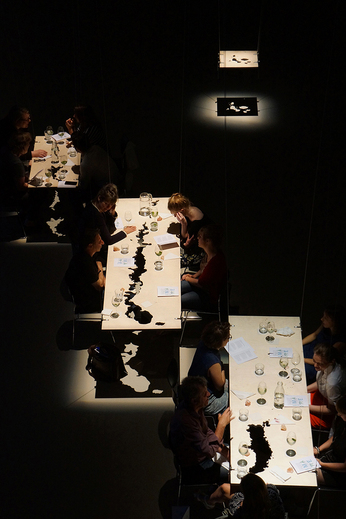-
From Current Issue
-
- Editor’s Letter Fire in the Heart
- Reviews I Gusti Ayu Kadek Murniasih
- Reviews 11th Seoul Mediacity Biennale: “One Escape at a Time”
- Dispatch Networked China
- One on One Monira Al Qadiri on Yukio Mishima
- Essays The rise of independent art spaces in pandemic-era Shanghai
- Features Tuan Andrew Nguyen
- Table of Contents
- Web Exclusives
- Archive
- Subscribe

R
E
V N
E
X
T
There is a species of killer Japanese knotweed that, over the years, has invaded Britain—and I’ve eaten it. This aggressively growing plant, which the Wildlife and Country Act of 1981 deemed a criminal species, and its presence around British homes have even prevented people from getting mortgages (an important factor in a country where a man’s home is his castle)—but I’ve eaten it. Cooking Sections, a London-based research duo, offered it to me in ice cream form during a consultation at their “Empire Remains Shop,” a performative installation on the 2nd floor of 91–93 Baker Street, London.
Their temporary shop, accessed via Crawford Street, is a manifestation of their longer-term critical exploration of the failed British government project “Empire Shops,” which was developed to promote colonial trade in the 1920s and ’30s. These stores were intended to make a new market and class for the British consumer, confident with imperial products such as sultanas from Australia, oranges from Palestine and cloves from Zanzibar. Resurrecting these plans, Cooking Sections (comprising Daniel Fernández Pascual and Alon Schwabe) is showcasing the gastronomical and agricultural legacies of this venture through a number of “products” and events.
The Shop installation is best thought of as individual investigations, each suited for display at a museum. Take one of the Shop’s items, The Forest Does Not Employ Me Any More (2016), a collaboration with the Forager Collective. This piece is a series of low, crescent-shaped stool structures made from branches of Lantana Camara. These have a bamboo appearance and are grouped together like shield bugs ready to infest. A bright sales assistant bounces from the Shop’s office to tell me all about the plant. Her pitch is a lesson in articulation and a well-versed rendition of the history of the plant’s introduction to India by the East India Company in 1807. During this time, Lantana Camara was at the height of botanical fashion. Its delicate flowers, which turn from bright yellow to red with age, were beguiling for both colonialists and butterflies.
The plant, however, has had more than aesthetic impact. Since its introduction, it has spread across 13 million hectares in India and impacted farming and patterns of tribal subsistence, particularly in the southwest state of Karnataka. The stools in The Forest Does Not Employ Me Any More are made at at the Lantana Crafts Centre, in the Malé Mahadeshwara Reserve Forest (MM hills) of Karnataka, and are intended to develop a sustainable income stream, with the aim of creating enough demand for them so that further spreading of the plant can be stopped.
Close by we are offered the chance to purchase more goods. My now-personal sales assistant leads me to Today We Are Green (2015). We stand by a discrete electronic counter mounted on the wall showing a set of flickering red numbers, which note the day’s oil price from the NASDAQ stock market. This is connected by a thin wire to a rustic, wooden rum cask laid on its side and mounted by a tin biofuel can. “Prices are high, do you want to buy a bottle of bioethanol?” I am asked. Although I decline, the taps on each can means this is a purchasable reality; depending on prices for the day, either fuel or rum is served. It is meant as a reflection on the evolving sugar industry, which Caribbean nations are currently re-appropriating.
The Shop’s investigations are consistently effective in meeting at the intersection of earnestness and wit. In Under the Sea There Is A Hole (2015), a number of wooden tiles, delicately suspended at different heights by wire line from the ceiling, have been cut through in shapes representing the risk-zone area of a map of the Dead Sea. Each tile represents the potential addition to this crumbling landscape, which has left craters beneath the water following the extraction of fertilizers, dam building and over-used water resources in the region, which link back to the time of the British Mandate of Palestine (1922–1948). However, for three evenings (August 24, September 21 and later next month, on October 13), this apocalyptic image transformed, becoming tables for “Climavore,” a performative dinner event based on the concept of envisioning a new cycle of seasons.
There is perhaps too much probing and points being made by the Shop and its collateral programming. At times it would benefit from being streamlined. For example, Hunger, A Man-Made Object – Speculation (2016), Asunción Molinos’s piece that hangs in the window, felt peripheral. It is evident, however, that the core concept is strong, and that Cooking Sections are insightful researchers. Thankfully they want to share their project. The plan, as they tell me, is to franchise : “You know like Coca Cola. [Except that] We’ll give the secret formula.”
Cooking Sections’ “The Empire Remains Shop” is on view at 91–93 Baker Street, London, until November 6, 2016.






